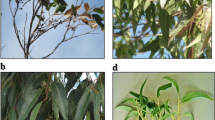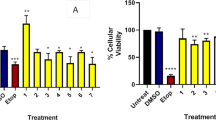Abstract
Treatment options for pancreatic cancer (PC) are severely limited due to late diagnosis, early metastasis and the inadequacy of chemotherapy and radiotherapy to combat the aggressive biology of the disease. In recent years, plant-derived bioactive compounds have emerged as a source of novel, anti-cancer agents. Used in traditional medicine worldwide, Elaeocarpus species have reported anti-inflammatory, antioxidant and anti-cancer properties. This study aimed to isolate and identify potential anti-PC compounds in the fruit of Elaeocarpus reticulatus Sm. A 50% acetone crude extract significantly decreased the viability of four pancreatic cell lines (≥ 10 µg/mL for BxPC-3 cells) and induced apoptosis in BxPC-3 and HPDE cells. Analysis by HPLC identified the triterpenoid Cucurbitacin I as a likely component of the extract. Furthermore, treatment with Cucurbitacin I significantly reduced the viability of HPDE and BxPC-3 cells, with results comparable to the same concentration of gemcitabine. Interestingly, attempts to isolate bioactive compounds revealed that the crude extract was more effective at reducing PC-cell viability than the fractionated extracts. This study provides initial insight into the bioactive constituents of E. reticulatus fruits.







Similar content being viewed by others
Abbreviations
- CCK-8:
-
Cell counting kit 8
- FBS:
-
Fetal bovine serum
- HPLC:
-
High-performance liquid chromatography
- PC:
-
Pancreatic cancer
References
Siegel RL, Miller KD, Jemal A (2018) Cancer statistics. CA Cancer J Clin 68(1):7–30
Rawla P, Sunkara T, Gaduputi V (2019) Epidemiology of pancreatic cancer: global trends, etiology and risk factors. World J Oncol 10(1):10–27
Ilic M, Ilic I (2016) Epidemiology of pancreatic cancer. World J Gastroenterol 22(44):9694–9705
Falasca M, Kim M, Casari I (2016) Pancreatic cancer: current research and future directions. BBA Rev Cancer 1865:123–132
Hashimoto D et al (2016) Heterogeneity of KRAS mutations in pancreatic ductal adenocarcinoma. Pancreas 45(8):1111–1114
Verbeke C (2016) Morphological heterogeneity in ductal adenocarcinoma of the pancreas—does it matter? Pancreatology 16(3):295–301
Kleppe M, Levine RL (2014) Tumor heterogeneity confounds and illuminates: assessing the implications. Nat Med 20(4):342–344
Apaya MK, Chang MT, Shyur LF (2016) Phytomedicine polypharmacology: cancer therapy through modulating the tumor microenvironment and oxylipin dynamics. Pharmacol Ther 162:1–206
Apte MV et al (2013) A starring role for stellate cells in the pancreatic cancer microenvironment. Gastroenterology 144(6):1210–1219
Jiang J-H et al (2015) Epithelial–mesenchymal transition in pancreatic cancer: is it a clinically significant factor? BBA Rev Cancer 1855:43–49
Abel EV, Simeone DM (2013) Biology and clinical applications of pancreatic cancer stem cells. Gastroenterology 144(6):1241–1248
Li Y et al (2013) Pancreatic cancer stem cells: emerging target for designing novel therapy. Cancer Lett 338(1):94–100
Tang B et al (2016) Calcium sensing receptor suppresses human pancreatic tumorigenesis through a novel NCX1/Ca/beta-catenin signaling pathway. Cancer Lett 377(1):44–54
Jones S et al (2008) Core signaling pathways in human pancreatic cancers revealed by global genomic analyses. Science 321(5897):1801–1806
Waddell N et al (2015) Whole genomes redefine the mutational landscape of pancreatic cancer. Nature 518(7540):495–501
Dimou F et al (2015) Trends in receipt and timing of multimodality therapy in early-stage pancreatic cancer. J Gastrointest Surg 20(1):93–103
Conroy T et al (2011) FOLFIRINOX versus gemcitabine for metastatic pancreatic cancer. New Engl J Med 364(19):1817–1825
Chiorean EG, Coveler AL (2015) Pancreatic cancer: optimizing treatment options, new, and emerging targeted therapies. Drug Des Dev Ther 9:3529–3545
Iorio MV, Croce CM (2012) MicroRNA dysregulation in cancer: diagnostics, monitoring and therapeutics. A comprehensive review. EMBO Mol Med 4(3):143–159
Bhanot A, Sharma R, Noolvi MN (2011) Natural sources as potential anti-cancer agents: a review. Int J Phytomed 3(1):18
Tewari D, Rawat P, Singh PK (2019) Adverse drug reactions of anticancer drugs derived from natural sources. Food Chem Toxicol 123:522–535
Newman DJ, Cragg GM (2012) Natural products as sources of new drugs over the 30 years from 1981 to 2010. J Nat Prod 75(3):311–335
Liu LF et al (2000) Mechanism of action of camptothecin. Ann N Y Acad Sci 922(1):1–10
Dumontet C, Jordan MA (2010) Microtubule-binding agents: a dynamic field of cancer therapeutics. Nat Rev Drug Discov 9(10):790–803
Vaccaro V et al (2015) Metastatic pancreatic cancer: is there a light at the end of the tunnel? World J Gastroenterol 21(16):4788–4801
Gardner ER et al (2008) Randomized crossover pharmacokinetic study of solvent-based paclitaxel and nab-paclitaxel. Clin Cancer Res 14(13):4200–4205
Passacantilli I et al (2018) Co-treatment with gemcitabine and nab-paclitaxel exerts additive effects on pancreatic cancer cell death. Oncol Rep 39(4):1984–1990
Mohanty S, Cock IE (2012) The chemotherapeutic potential of Terminalia ferdinandiana: phytochemistry and bioactivity. Pharmacogn Rev 6(11):29–36
Vuong QV et al (2014) Fruit-derived phenolic compounds and pancreatic cancer: perspectives from Australian native fruits. J Ethnopharmacol 152(2):227–242
Pandey KB, Rizvi SI (2009) Plant polyphenols as dietary antioxidants in human health and disease. Oxid Med Cell Longev 2(5):270–278
Rickard S (2011) The new ornamental garden. CSIRO Publishing Gardening Guides, Collingwood
Vuong QV et al (2018) Fruit characteristics, phytochemical and antioxidant properties of blueberry ash (Elaeocarpus reticulatus). Heliyon 4(10):e00834
Michael JP (2016) Chapter one—Simple indolizidine and quinolizidine alkaloids. In: Hans-Joachim K (ed) The alkaloids: chemistry and biology. Academic Press, Cambridge, pp 1–498
Singh RK, Bhattacharya SK, Acharya SB (2000) Studies on extracts of Elaeocarpus sphaericus fruits on in vitro rat mast cells. Phytomedicine 7(3):205–207
Garg K, Goswami K, Khurana G (2013) A pharmacognostical review on Elaeocarpus sphaericus. Int J Pharm Pharm Sci 5:3–8
Utami R et al (2013) Phenolic contents, antioxidant and cytotoxic activities of Elaeocarpus floribundus Blume. Pak J Pharm Sci 26(2):245–250
Hule AK et al (2011) An evaluation of the antidiabetic effects of Elaeocarpus ganitrus in experimental animals. Indian J Pharmacol 43(1):56–59
Singh B et al (2015) Phytochemical and biological aspects of Rudraksha, the stony endocarp of Elaeocarpus ganitrus (Roxb.): a review. Isr J Plant Sci 62(4):1–11
Geetha DH, Rajeswari M, Jayashree I (2013) Chemical profiling of Elaeocarpus serratus L. by GC-MS. Asian Pac J Trop Biomed 3(12):985–987
Joshi S et al (2012) A comprehensive report on therapeutic potential of Elaeocarpus ganitrus Roxb.(Rudraksha). Environ Conserv J 13(3):147–150
Meng D et al (2008) Cytotoxic cucurbitane-type triterpenoids from Elaeocarpus hainanensis. Planta Med 74(14):1741–1744
Fang X et al (1984) Plant anticancer agents, XXXIV. Cucurbitacins from Elaeocarpus dolichostylus. J Nat Prod 47(6):988–993
Harden GJ (2005) Flora of New South Wales, Vol. 1. University of NSW Press, Royal Botanic Gardens Sydney, Sydney
Ouyang H et al (2000) Immortal human pancreatic duct epithelial cell lines with near normal genotype and phenotype. Am J Pathol 157(5):1623–1631
Schoumacher RA et al (1990) A cystic fibrosis pancreatic adenocarcinoma cell line. Proc Natl Acad Sci USA 87(10):4012–4016
Tan MH et al (1986) Characterization of a new primary human pancreatic tumor line. Cancer Invest 4(1):15–23
Yunis AA, Arimura GK, Russin DJ (1977) Human pancreatic carcinoma (MIA PaCa-2) in continuous culture: sensitivity to asparaginase. Int J Cancer 19(1):128–135
Do QD et al (2014) Effect of extraction solvent on total phenol content, total flavonoid content, and antioxidant activity of Limnophila aromatica. J Food Drug Anal 22(3):296–302
Alothman M, Bhat R, Karim AA (2009) Antioxidant capacity and phenolic content of selected tropical fruits from Malaysia, extracted with different solvents. Food Chem 115(3):785–788
Dai J, Mumper RJ (2010) Plant phenolics: extraction, analysis and their antioxidant and anticancer properties. Molecules 15(10):7313
Xuan TD et al (2007) Efficacy of extracting solvents to chemical components of kava (Piper methysticum) roots. J Nat Med 62(2):188
Symonds EL, Konczak I, Fenech M (2013) The Australian fruit Illawarra plum (Podocarpus elatus Endl., Podocarpaceae) inhibits telomerase, increases histone deacetylase activity and decreases proliferation of colon cancer cells. Br J Nutr 109(12):2117–2125
Tan AC et al (2011) Native Australian fruit polyphenols inhibit cell viability and induce apoptosis in human cancer cell lines. Nutr Cancer 63(3):444–455
Varughese B, Tripathi J (2013) Phytochemical evaluation of different solvent extracts of Aegle marmelos fruit at different stages of its ripening. Adv Life Sci Technol 8:8–12
Gami B (2016) Screening of methanol & acetone extract for antimicrobial activity of some medicinal plants species of Indian folklore. Int J Res Pharm Sci 2(1):69–75
Zhu ZX et al (2010) [Effects of gemcitabine and pemetrexed on the proliferation of pancreatic cancer cell lines BXPC-3 and PANC-1 in vitro]. Nan Fang Yi Ke Da Xue Xue Bao 30(1):149–152
Cappella P et al (2001) Cell cycle effects of gemcitabine. Int J Cancer 93(3):401–408
Habiro A et al (2004) Involvement of p38 mitogen-activated protein kinase in gemcitabine-induced apoptosis in human pancreatic cancer cells. Biochem Biophys Res Commun 316(1):71–77
de S Cavalcante, L. and Monteiro G (2014) Gemcitabine: metabolism and molecular mechanisms of action, sensitivity and chemoresistance in pancreatic cancer. Eur J Pharmacol 741:8–16
Yong-Xian G et al (2016) Gemcitabine inhibits proliferation and induces apoptosis in human pancreatic cancer PANC-1 cells. J Cancer Res Ther 12(5):1–4
Hamed SS, Straubinger RM, Jusko WJ (2013) Pharmacodynamic modeling of cell cycle and apoptotic effects of gemcitabine on pancreatic adenocarcinoma cells. Cancer Chemother Pharmacol 72(3):553–563
Jaganathan R et al (2013) Potential therapeutic role of Tridham in human hepatocellular carcinoma cell line through induction of p53 independent apoptosis. BMC Complement Altern Med 13(1):323
Liu RH (2004) Potential synergy of phytochemicals in cancer prevention: mechanism of action. J Nutr 134(12):3479S-3485S
Rasoanaivo P et al (2011) Whole plant extracts versus single compounds for the treatment of malaria: synergy and positive interactions. Malaria J 10(Suppl 1):S4–S4
Pan L et al (2012) Isolation, structure elucidation, and biological evaluation of 16,23-epoxycucurbitacin constituents from Eleaocarpus chinensis. J Nat Prod 75(3):444–452
Ito A et al (2002) Ellagic acid derivatives and cytotoxic cucurbitacins from Elaeocarpus mastersii. Phytochemistry 61(2):171–174
Alghasham AA (2013) Cucurbitacins—a promising target for cancer therapy. Int J Health Sci 7(1):77–89
Zhang Z-R, Gao M-X, Yang K (2017) Cucurbitacin B inhibits cell proliferation and induces apoptosis in human osteosarcoma cells via modulation of the JAK2/STAT3 and MAPK pathways. Exp Ther Med 14(1):805–812
Sikander M et al (2016) Cucurbitacin D exhibits potent anti-cancer activity in cervical cancer. Sci Rep 6:36594
Blaskovich MA et al (2003) Discovery of JSI-124 (Cucurbitacin I), a selective janus kinase/signal transducer and activator of transcription 3 signaling pathway inhibitor with potent antitumor activity against human and murine cancer cells in mice. Cancer Res 63(6):1270–1279
Qi J et al (2015) JSI-124 (Cucurbitacin I) inhibits tumor angiogenesis of human breast cancer through reduction of STAT3 phosphorylation. Am J Chin Med 43(2):337–347
Acknowledgements
A.T is supported by an Australian Government Research Training Program Scholarship. E.B is supported by in NHMRC Early Career Fellowship. This work was funded by internal departmental funds from the University of Newcastle only.
Author information
Authors and Affiliations
Corresponding author
Ethics declarations
Conflict of interest
The authors declare that there is no conflict of interest.
Additional information
Publisher's Note
Springer Nature remains neutral with regard to jurisdictional claims in published maps and institutional affiliations.
Rights and permissions
About this article
Cite this article
Turner, A., Bond, D.R., Vuong, Q.V. et al. Elaeocarpus reticulatus fruit extracts reduce viability and induce apoptosis in pancreatic cancer cells in vitro. Mol Biol Rep 47, 2073–2084 (2020). https://doi.org/10.1007/s11033-020-05307-8
Received:
Accepted:
Published:
Issue Date:
DOI: https://doi.org/10.1007/s11033-020-05307-8




